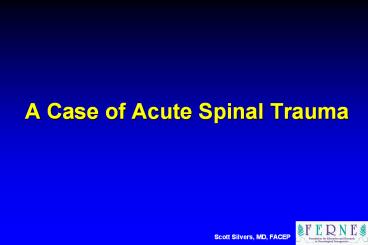A Case of Acute Spinal Trauma - PowerPoint PPT Presentation
1 / 18
Title:
A Case of Acute Spinal Trauma
Description:
Review the clinical presentation. Review the injury grading scales. Discuss the management ... Case Study: Spinal Cord Injury. 16 yo male. Trampoline for his birthday ... – PowerPoint PPT presentation
Number of Views:106
Avg rating:3.0/5.0
Title: A Case of Acute Spinal Trauma
1
A Case of Acute Spinal Trauma
Scott Silvers, MD, FACEP
2
Scott Silvers, MD, FACEPAssistant Professor
Co-Director Primary Stroke Center Department of
Emergency MedicineMayo Clinic College of
MedicineJacksonville, Florida
3
ObjectivesAcute Spinal Cord Injury
- Review the clinical presentation
- Review the injury grading scales
- Discuss the management
- Introduce the potential late sequelae
4
Case Study Spinal Cord Injury
- 16 yo male
- Trampoline for his birthday
- Brought EMS 2 IVs, backboard, C-collar
- Nasal intubation in the field
- VS P 128 BP 90/55
- Alert
- No spontaneous movement or reflexes
5
X Ray
6
X Ray 2
7
Picture
8
SCI Subtypes
- Complete
- Complete transection of motor and sensory tracts
- Incomplete
- Central Cord Syndrome
- Anterior Cord Syndrome
- Posterior Cord Syndrome
- Brown Sequard Syndrome
9
Neurologic Examination
- Document all findings
- Level of consciousness
- Motor strength
- Sensation to light touch and pinprick
- Diaphragm, abdominal, and sphincter function
- DTRs, plantar reflexes, sacral reflexes
- Position sense
- Sacral sparing (perineal sensation, sphincter
tone)
10
Picture 2
11
ASIA Impairment Scale
- A Complete
- B Incomplete
- Sensory, but no motor function below neurological
level - C Incomplete
- Motor function preserved below level muscle
grade lt 3 - D Incomplete
- Motor function preserved below level muscle
grade gt 3 - E Normal
12
Complete Cord
- No sensation
- Flaccid paralysis
- Initially areflexia
- Hyperreflexia, spasticity, positive planter
reflex ( after days to months) - lt5 chance of functional recovery if no
improvement within 24 hours
13
Traumatic SCI Management
- ABCs Treat / prevent hypoxia and hypotension
- Stabilize the spine to prevent additional injury
- Rule out other serious injuries
- Careful neurological examination
- Level of neurological impairment
- Imaging
- Neuroprotective pharmacotherapy?
- Early rehabilitation
14
Guidelines for the Management of Acute Cervical
Spine and SCI. Neurosurg 200250 (suppl) 1-200
- Evidence based practice guideline
- 22 chapters
- Pharmacologic therapy most controversial
- Preface 17 pages of editorial commentary
15
IX. Pharmacological Therapy after Acute Cervical
Spinal Cord Injury
- Recommendations Corticosteroids
- Standards None
- Guidelines None
- Options Treatment with methylprednisolone for
either 24 or 48 hours is recommended as an option
in the treatment of patients with acute spinal
cord injury within 12 hours of injury.
16
IX. Pharmacological Therapy after Acute Cervical
Spinal Cord Injury
- B) GM-1 Ganglioside
- Standards None
- Guidelines None
- Options Treatment of acute spinal cord injury
patients with GM-1 ganglioside is an option for
treatment without clear evidence of clinical
benefit or harm.
17
Mortality
- Mortality highest in the 1st year after injury
- If paraplegia at age 20, average life expectancy
of 44 years vs 57 years for the general
population - Leading causes of death are
- Pneumonia, PE, heart disease, and sepsis
- (No longer Renal failure)
18
ConclusionsSpinal Cord Injury (SCI)
- Basis for acute management is preventing
additional injury and providing supportive care - Role methylprednisolone is questionable
- Acute SCI above T7 has low sympathetic activity
- Chronic SCI has high sympathetic activity
- Pneumonia, PE, and sepsis are the most common
causes of death in chronic SCI
19
Questions?? www.ferne.orgferne_at_ferne.orgScott
Silvers, MDsilvers.scott_at_mayo.edu
Scott M. Silvers MD, FACEP































